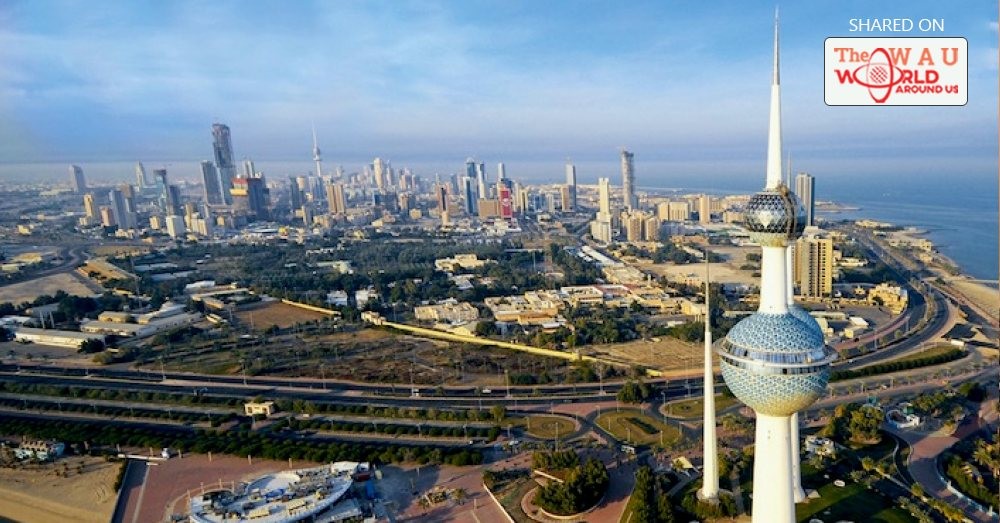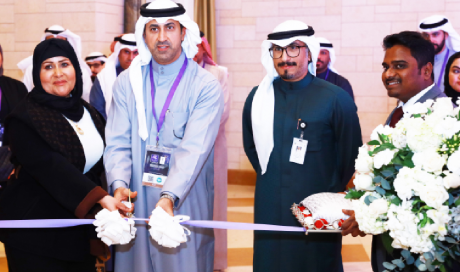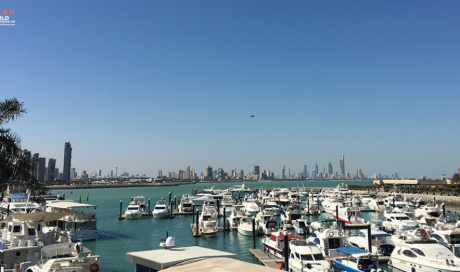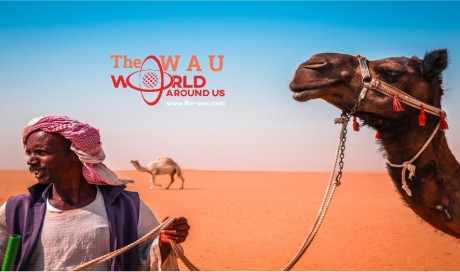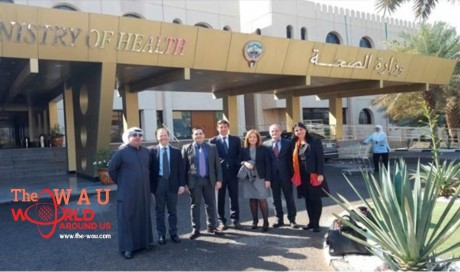ABOUT KUWAIT
State of Kuwait:
Kuwait officially the State of Kuwait, is a country in Western Asia. Situated in the northern edge of Eastern Arabia at the tip of the Persian Gulf, it shares borders with Iraq and Saudi Arabia. Kuwait has a total boundary length of 462 kilometers, and a coastline of 499 kilometers. Kuwait is a constitutional emirate with a high income economy backed by the world's sixth largest oil reserves. The total land area is 17,819 sq km. The Kuwaiti dinar is the highest valued currency in the world. According to the World Bank, the country has the fourth highest per capita income in the world.
In 1613, the town of Kuwait was founded in modern-day Kuwait City. In 1716, the Bani Utubs settled in Kuwait, which at this time was inhabited by a few fishermen and primarily functioned as a fishing village. In the eighteenth century, Kuwait prospered and rapidly became the principal commercial center for the transit of goods between India, Muscat, Baghdad and Arabia. Kuwait was the center of boat building in the Persian Gulf region. During the late eighteenth and nineteenth centuries, vessels made in Kuwait carried the bulk of trade between the ports of India, East Africa and the Red Sea. Kuwaiti ships were renowned throughout the Indian Ocean.
From 1946 to 1982, Kuwait experienced a period of prosperity driven by oil and its liberal atmosphere. In popular discourse, the years between 1946 and 1982 are referred to as the "Golden Era". The country became the largest oil exporter in the Persian Gulf region. This massive growth attracted many foreign workers, especially from Palestine, Egypt and India. In June 1961, Kuwait became independent with the end of the British protectorate and the sheikh Abdullah Al-Salim Al-Sabah became an Emir. Under the terms of the newly drafted constitution, Kuwait held its first parliamentary elections in 1963. Kuwait was the first Gulf country to establish a constitution and parliament.
In the early 1980s, Kuwait experienced a major economic crisis after the Souk Al-Manakh stock market crash and decrease in oil price. During the Iran-Iraq war, Kuwait supported Iraq. Throughout the 1980s, there were several terror attacks in Kuwait, including the 1983 Kuwait bombings, hijacking of several Kuwait Airways planes and attempted assassination of Emir Jaber in 1985. Kuwait was a regional hub of science and technology in the 1960s and 1970s up until the early 1980s, the scientific research sector significantly suffered due to the terror attacks.
After the Iran-Iraq war ended, Kuwait declined an Iraqi request to forgive its US$65 billion debt. An economic rivalry between the two countries ensued after Kuwait increased its oil production by 40 percent. Tensions between the two countries increased further in July 1990, after Iraq complained to OPEC claiming that Kuwait was stealing its oil from a field near the border by slant drilling of the Rumaila field.
In August 1990, Iraqi forces invaded and annexed Kuwait. After a series of failed diplomatic negotiations, the United States led a coalition to remove the Iraqi forces from Kuwait, in what became known as the Gulf War. The United States led an international coalition of Arab and other nations to demand the withdrawal of Iraqi forces. After a lengthy buildup of forces, Iraq was assaulted by massive air and land forces; after six weeks, its defenses collapsed and Kuwait was liberated in February 1991.
Economic and social development:
Kuwait has a petroleum-based economy; petroleum is the main export product. The Kuwaiti dinar is the highest-valued unit of currency in the world. According to the World Bank, Kuwait is the fourth richest country in the world per capita. Kuwait is the second richest GCC country per capita (after Qatar). Petroleum accounts for half of GDP and 90% of government income. Non-petroleum industries include financial services.
In the past five years, there has been a significant rise in entrepreneurship and small business start-ups in Kuwait. The informal sector is also on the rise, mainly due to the popularity of Instagram businesses.
Kuwait is a major source of foreign economic assistance to other states through the Kuwait Fund for Arab Economic Development, an autonomous state institution created in 1961 on the pattern of international development agencies. In 1974, the fund's lending mandate was expanded to include all developing countries in the world.
Kuwait has proven crude oil reserves of 104 billion barrels, estimated to be 10% of the world's reserves. According to the constitution, all natural resources in the country are state property. Kuwait currently pumps 2.9 million bpd and its full production capacity is a little over 3 million bpd.
The Kuwait Investment Authority (KIA) is Kuwait's sovereign wealth fund specializing in foreign investment. The KIA is the world's oldest sovereign wealth fund. Since 1953, the Kuwaiti government has directed investments into Europe, United States and Asia Pacific. As of 2015, the holdings were valued at $592 billion in assets. It is the 5th largest sovereign wealth fund in the world.
Kuwait has a leading position in the financial industry in the GCC; the abyss that separates Kuwait from its Gulf neighbors in terms of tourism, transport, and other measures of diversification is absent in the financial sector. The Emir has promoted the idea that Kuwait should focus its energies, in terms of economic development, on the financial industry. The historical preeminence of Kuwait (among the Gulf monarchies) in finance dates back to the founding of the National Bank of Kuwait in 1952. The bank was the first local publicly traded corporation in the Gulf. In the late 1970s and early 1980s, an alternative stock market, trading in shares of Gulf companies, emerged in Kuwait, the Souk Al-Manakh. At its peak, its market capitalization was the third highest in the world, behind only the U.S. and Japan, and ahead of the UK and France.
Kuwait has a large wealth-management industry that stands out in the region. Kuwaiti investment companies administer more assets than those of any other GCC country, save the much larger Saudi Arabia. The Kuwait Financial Centre, in a rough calculation, estimated that Kuwaiti firms accounted for over one-third of the total assets under management in the GCC. The relative strength of Kuwait in the financial industry extends to its stock market. For many years, the total valuation of all companies listed on the Kuwaiti exchange far exceeded the value of those on any other GCC bourse, except Saudi Arabia.
In 2011, financial and banking companies made up more than half of the market capitalization of the Kuwaiti bourse; among all the Gulf States, the market capitalization of Kuwaiti financial-sector firms was, in total, behind only that of Saudi Arabia.
In recent years, Kuwaiti investment companies have invested large percentages of their assets abroad, and their foreign assets have become substantially larger than their domestic assets.
Location:
Kuwait is a small country located in the Middle East on the Persian Gulf, between Iraq and Saudi Arabia. It is a desert country with intensely hot summers and short, cool winters. The terrain varies minimally, between flat and slightly undulating desert plains.
Topographic Features:
Kuwait consists almost entirely of flat rolling desert and mud flats. There is a 1,137-m (450-ft) ridge at Mina' al-Ahmadi and a 290-m (951-ft) prominence in the southwest corner. There are no permanent rivers or lakes, but there are some desert wadis that collect water during the rains.
Land Area:
The total land area is approximately 17,819 sq km.
Population:
The population of Kuwait in 2005 was estimated by the United Nations (UN) at 2,589,000, which placed it at number 136 in population among the 193 nations of the world. According to the UN, the annual population rate of change for 2005–10 was expected to be 1.7%, a rate the government viewed as satisfactory. The projected population for the year 2025 was 4,610,000.
Capital City:
Kuwait city (Al-Kuwayt)
Official Language:
Arabic is the official language. English is generally used by businesspeople, employees of oil companies, foreign residents, and students, and it is the second language taught in the schools.
Climate:
During the summer, which lasts roughly from May to October, the air generally is dry, but southeasterly winds often raise day-time humidity to 90% for a few weeks in August or September. Between November and April, the climate is pleasant, with cool nights and warm sunny days. In December and January, night temperatures occasionally touch the freezing point.
Major Towns:
Al Ahmadi, Hawalli, As Salimiyah, Sabah as Salim.
Currency:
The Kuwaiti dinar (KD) is the currency of Kuwait. It is sub-divided into 1,000 fils. The Exchange parity has been set at the fixed rate of US $ =0.30KD’s
National Day:
Kuwait National Day is always celebrated on 25 February. This holiday marks the day when Sheikh Abdullah Al-Salem Al-Sabah ascended to the throne in 1950.
Public Holidays:
February 25: National Day
February 26: Liberation Day
May 05: Eid al Isra' Wal Mi'raj
July 05: Eid Al Fitr Holiday
National flag:
The flag of Kuwait was officially adopted on September 7, 1961. The traditional Pan-Arab colors of black, green, red and white are used on the flag.
Meaning of the flag:
A. Black symbolizes defeat of the country's enemies
B. green symbolizes the fertility of the land
C. red is symbolic of the enemies' bloodshed
D. white represents purity.
Work Hours:
The work week in Kuwait is Sunday to Thursday, with the weekend falling on Friday and Saturday. A standard working week is 40 hours, with companies usually operating between 8.30am and 6pm, sometimes with an extended lunch break. Office hours are reduced during the holy month of Ramadan.
Local Time:
3hours+Greenwich Mean Time.
Electrical Current:
240 Volts at 50 Hertz
Public Transport System:
Kuwait City has no shortage of transportation options whether for tourists or corporate travelers. Kuwait has a well-developed road system, although there are no trains, and public transport is limited to buses and taxis. The local bus system in Kuwait is cheap and extensive, but, is rather designed for convenience of local residents than tourists. The two state-owned public bus companies are KPTC (Kuwait Public Transport Company) and the City Bus.
The only airport in the country is the Kuwait international airport. Kuwait Public Transport Company not only offers bus services, but also offer ferry services daily. The ferries usually operate from Kuwait City to Failaka Island.
Public transport: http://kptc.com.kw/newenglish/index.html
Kuwait airlines: https://www.kuwaitairways.com/
Sports:
Kuwait is one of the wealthier Middle Eastern countries and is largely influenced by European sports. This is why it is no surprise that Kuwait has fallen in love with football. The Kuwait Football Association is the main governing body for anything football in the country. Another popular sport in Kuwait is basketball. Other sports that are gaining popularity in the region include cricket, handball and rugby union. The Kuwait national handball team is widely recognized as one of the very best in Asia and of the Arab world.
Kuwait national Olympic committee: https://www.olympic.org/kuwait
Telephone Code:
International code: +965
Area code: http://dialcodesplus.com/country/kuwait.html
Share This Post

